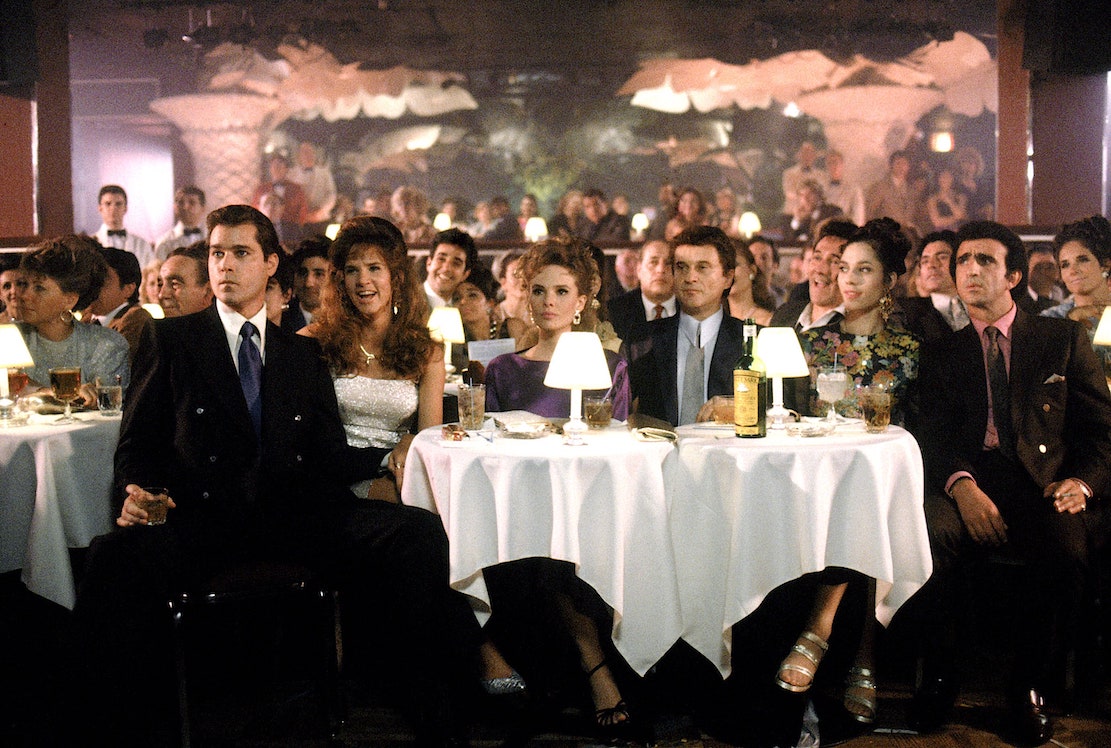MARIANI’S
Virtual
Gourmet
October 23 2022
NEWSLETTER
IS BRIAN LEWIS THE BEST CHEF
IN NEW ENGLAND?
By John Mariani
NEW YORK CORNER
AVRA ROCKEFELLER CENTER
By John Mariani
ANOTHER VERMEER
CHAPTER FORTY-TWO
By John Mariani
NOTES FROM THE WINE CELLAR
J. LOHR PLANS FOR THE FUTURE
By John Mariani
 Freedman, author of
CRUSHED Go to: WVOX.com.
The episode will also be archived at: almostgolden.
Freedman, author of
CRUSHED Go to: WVOX.com.
The episode will also be archived at: almostgolden.
PLACE YOUR BETS
.jpg)
PHOTOS BY LULI BURKE
From Greenwich, Connecticut, to
Portland, Maine, New England is blessed not only
with an extraordinary bounty
of food from the fields and woods and lakes and
sea but also, since the 1980s,
a generation of chefs who utilized that
provender to create a food culture as
rich as any in America.
Chefs like Nitzi Rabin of
Chillingsworth,  Daniel
Bruce
at the Boston Harbor Hotel, Ana Sortun of Oleana,
Jody Adams of Porto and
Melissa Kelly of Primo were the pioneers, and, in
so many ways, Brian Lewis is
heir to their experience and expertise over the
last decade, tying together
several culinary strains into a loose fabric at
his four restaurants, three in
Connecticut, one in Rye, New York.
Daniel
Bruce
at the Boston Harbor Hotel, Ana Sortun of Oleana,
Jody Adams of Porto and
Melissa Kelly of Primo were the pioneers, and, in
so many ways, Brian Lewis is
heir to their experience and expertise over the
last decade, tying together
several culinary strains into a loose fabric at
his four restaurants, three in
Connecticut, one in Rye, New York.
I first enjoyed Lewis’s cooking at the
Bedford Post Inn, when it was opened by actors
Richard Gere and his wife Carey
Lowell, then at his own place, Elm, in New Canaan,
where he was already showing
a talent for Asian flavors and techniques he
furthered at The Cottage in
Westport. So entranced by Japanese cuisine was Lewis
that he opened OKO, in
both Westport and Rye, as a superlative rendering of
sushi and other innovative
delicacies that go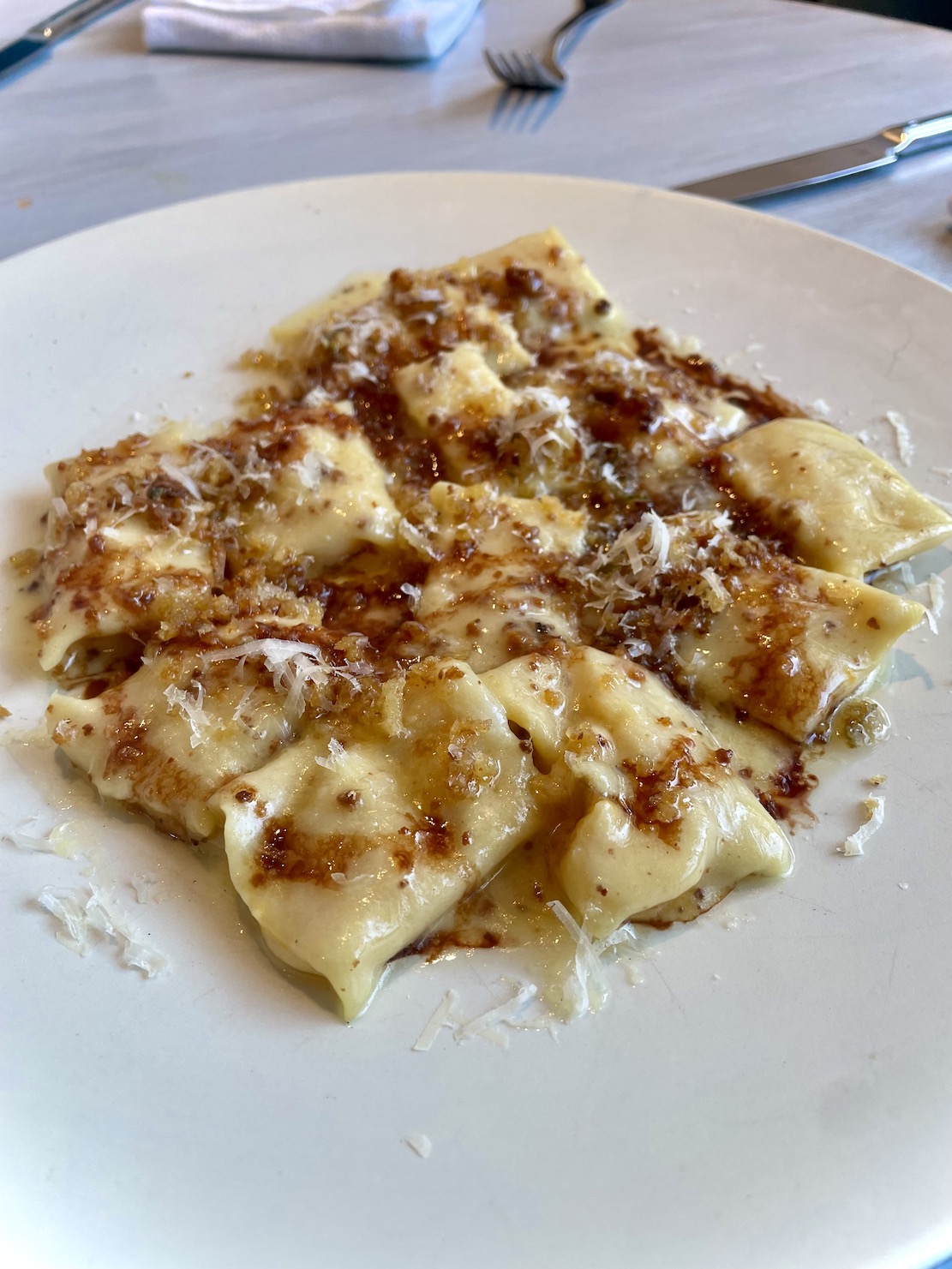 far beyond the
usual offerings.
far beyond the
usual offerings.
A return visit this month to the Westport
Cottage, followed by a first visit to the Greenwich
Cottage, strongly indicated
that Lewis is at the top of his form in refining his
techniques and focus. I
have rarely tasted so many dishes that seemed so
well conceived and so
thoroughly worked through so that every
ingredient—as many as possible from
local purveyors—complements the rest with a sure
balance of richness,
seasonings and textures.
Thus, everything in his Fort Hill Farm
tomato salad of Romaine lettuce, a basil aïoli,
pancetta bacon and brioche
crouton ($18) was the best of the season. A simple
starter of creamy house-made
ricotta spread on sourdough toast with tiger figs,
pistachios and balsamico
($17) opened the palate on a lush note, followed by
a wild fluke crudo
enlivened by tangy Sicilian
orange, anise-like 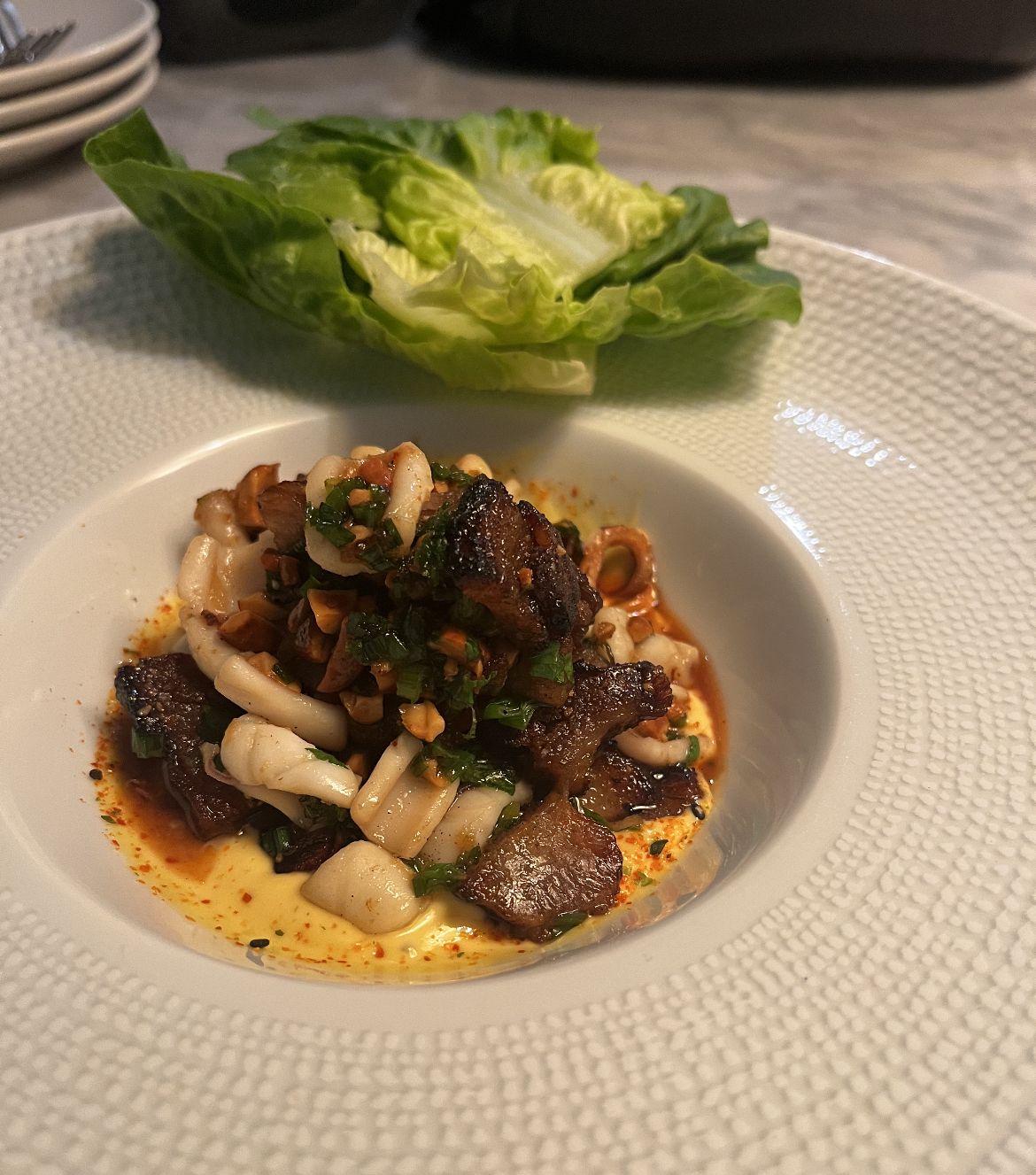 fennel and Serrano chili
($19). A cream-colored velouté of
local corn with peekytoe crab, jalapeño salsa and
cool melon ($18) was a
delicate but vibrant pleasure.
fennel and Serrano chili
($19). A cream-colored velouté of
local corn with peekytoe crab, jalapeño salsa and
cool melon ($18) was a
delicate but vibrant pleasure.
Regulars
refuse to allow Lewis ever to
remove a fried rice dish from his menu, at Westport
tossed with lobster, plum,
sesame and oozy quail eggs ($23), or the
wagyu brisket Asian buns with Napa kimchi,
duck fat potato tempura and ink aïoli ($12 each).
Then there are always
sumptuous, house-made pastas, like the
signature corn tortelloni laced
with
basil oil and a good dose of Parmigiano ($19/$29).
Main courses, which include
a very good burger with Comté cheese and sriacha
aïoli ($24), revel in Atlantic
bounty in dishes like firm Rhode Island black bass
with fregola grain, almonds, caramelized
fennel and mussels ($38), and
New Jersey scallops with corn and bacon succotash,
romesco and Maxibel pecans
($39).
All sections of the menu are of the same
fabric, so desserts match the preceding dishes, like
Lindsay Shere’s almond
cake with ripe peaches and rich mascarpone ($13),
and dark chocolate s’mores
plus graham cracker crumb and toasted meringue
($13). For all these
ingredients, these dishes all seem sensibly priced,
and you’ll undoubtedly
share some. 
The premises at Westport are cozy in
their barn wood veneer, but that means it can get
very loud when there’s a full
main dining room; ask to sit in the bar.
Twenty
minutes away at the new Greenwich
Cottage, I expected to find more or less
the same menu as in Westport, yet
Lewis wants his new baby to walk on her own, so the
menu there begins with
spicy squid and fatted pork belly with kumquat
citrus-chili kosho, cashews and
squid caramel ( $19), and a wonderful miso black cod
with shiitake marmalade,
“ember” aïoli and buckwheat crêpe ($23). The fried
rice dish is made with duck
($21.) The pastas include a very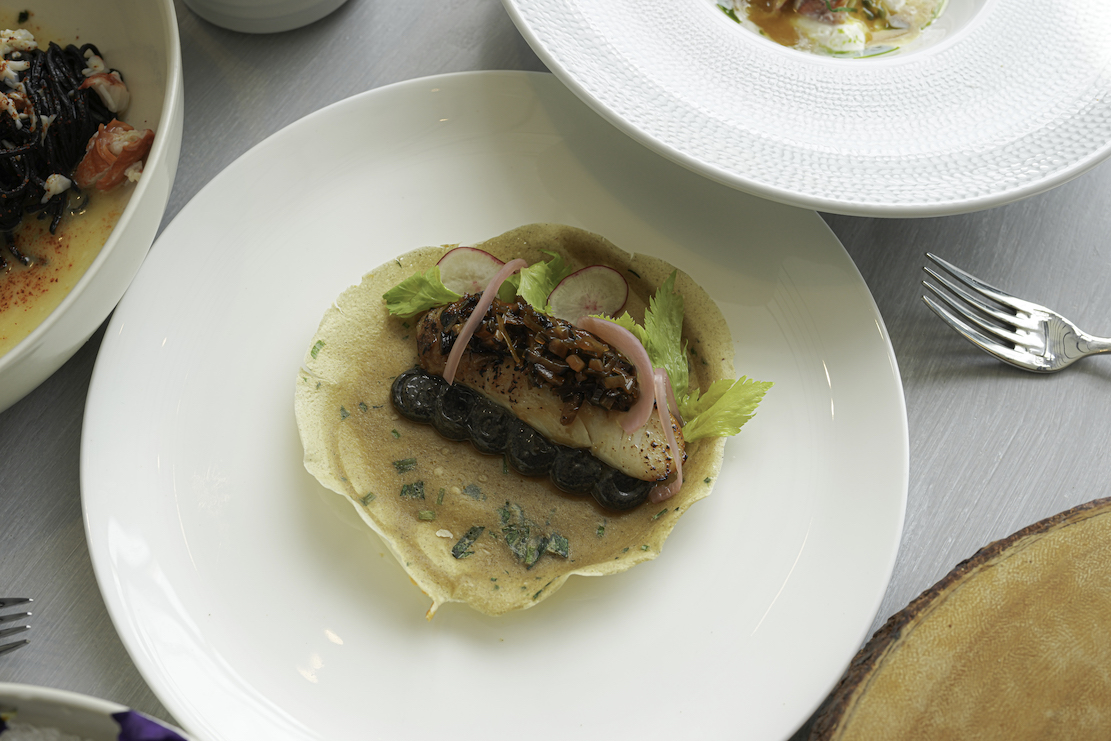 rich foie gras stuffed into cappellacci
with Sherry-laced
prunes and toasted almonds ($24/$34) and corsetti
impressed with a stamp figure and served with sweet
Gorgonzola and a hazelnut
prosciutto crumble ($18/$28).
rich foie gras stuffed into cappellacci
with Sherry-laced
prunes and toasted almonds ($24/$34) and corsetti
impressed with a stamp figure and served with sweet
Gorgonzola and a hazelnut
prosciutto crumble ($18/$28).
Among the
main dishes is Maine halibut
baked in spruce with cauliflower and kale and
pickled grapes and burnt onion
($42). Casco Bay cod is perfumed with garlic oil and
served with cocoa beans,
sweet buttery leeks and a confit of egg yolk and
chorizo sabayon ($39). Wagyu
beef short ribs in Barolo is a bit too much of a
good thing, amplified with
dried cherry and walnut Shropshire crumbs on
mascarpone grits ($55); in this,
less would have been more than enough. I had my
first venison saddle of the
season, roasted with juniper and thyme, as well as
brown butter parsnips,
chanterelles and huckleberries ($48),
the epitome of autumn.
And for dessert it was good old fashioned
carrot cake ennobled
with buttermilk
sorbet and coffee walnut crumble ($13) as well as
“drunken affogato” of vanilla
gelato with a 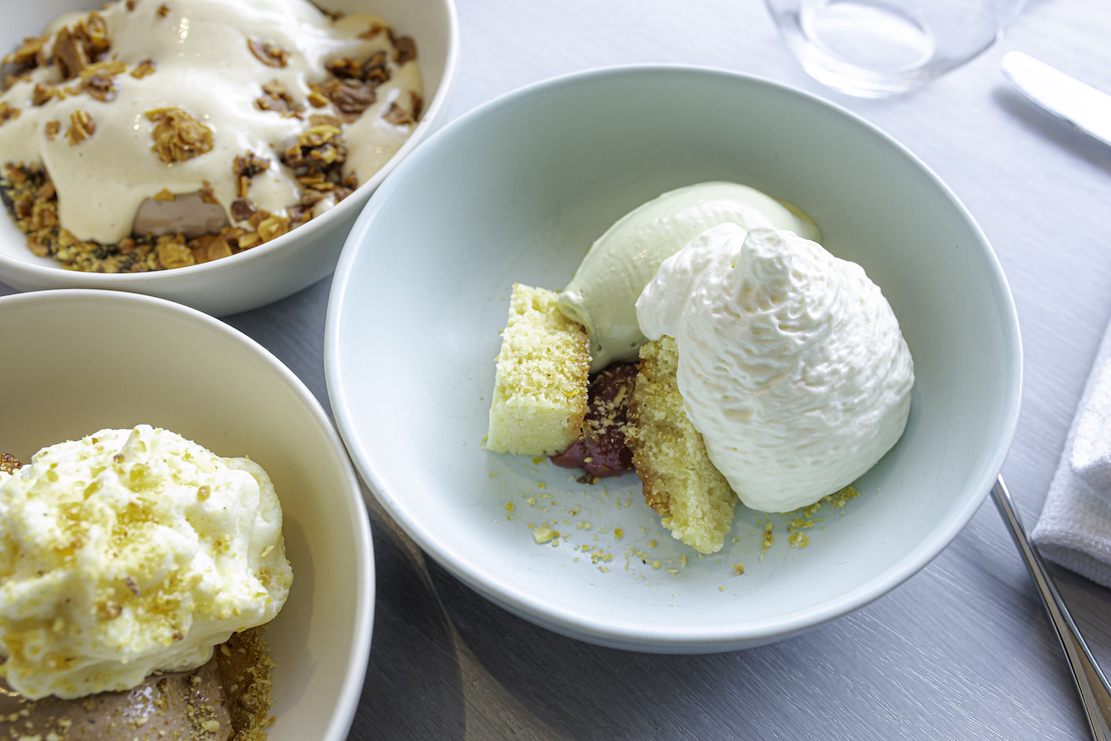 pour of black
apple rum and espresso ($11).
pour of black
apple rum and espresso ($11).
The dining room in Greenwich, quite sunny
during the day, has a pleasant lighting during the
evening and the cheery
colors of the sea. Depending on who’s sitting next
to you —pray it is not table
of investment bankers celebrating the purchase of a
hotel chain (not untypical
among Greenwich loudmouths)—the noise level varies.
Both Cottage restaurants have good, solid
wine lists with a sufficient number by the glass,
most around $16.
I am always anxious when a chef—and high
praise should go to Lewis’s sous-chefs and cooks for
consistency—branches out
too widely and quickly, so often losing control. But Lewis
is now showing a true mastery of a
form one might call New England tradition with
sensible Pacific notes that make
his cuisine all the more impressive.
Is he
the best chef in New England? When
I get around to all of them, I’ll let you know. But
right now, Brian Lewis is
garnering gold.
1271 Avenue of the
Americas
212-430-8888
.jpg)
It was a windy, rain-swept October
Monday night in
Manhattan. The Broadway theaters were dark, so
was Radio City Music Hall. Yet
the five-month-old Avra Rockefeller Center’s 400
seats were packed by 7:15,
spread over three huge floors and at its long
bar. The smartly dressed
hostesses were scurrying to acknowledge and seat
people pushing their way
through the tall revolving doors. There were
after-work guys unwinding at the
bar; women dressed to the nines; slobs in
t-shirts ordering platters of shellfish;
suits discussing business;
parties of celebratory families. Just a
typical Monday night in NYC.
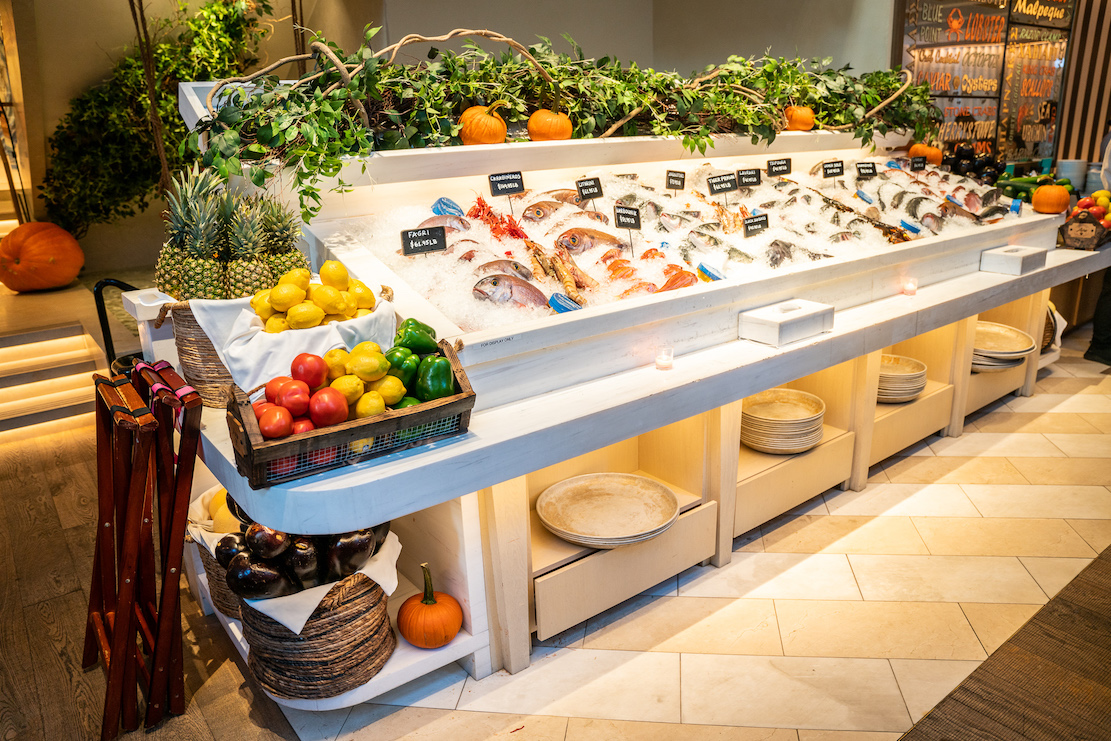 They
might have gone to other grand
dining spaces nearby, like Oceana, Del Frisco’s,
Le Rock or Milos, even to
Avra’s two, older siblings east of Fifth Avenue.
But here was a crowd of people
who came not because Avra is new or trendy, or
rich in celebrities; nor had it
even been reviewed one way or the other by the New
York media. Clearly the
crowd was at Avra RC because it is a dazzling
16,500-square-foot space in the
former Time-Life Building, which, after a $600
million renovation, has managed
to lease just about every space.
They
might have gone to other grand
dining spaces nearby, like Oceana, Del Frisco’s,
Le Rock or Milos, even to
Avra’s two, older siblings east of Fifth Avenue.
But here was a crowd of people
who came not because Avra is new or trendy, or
rich in celebrities; nor had it
even been reviewed one way or the other by the New
York media. Clearly the
crowd was at Avra RC because it is a dazzling
16,500-square-foot space in the
former Time-Life Building, which, after a $600
million renovation, has managed
to lease just about every space.
The Avra
Group’s Nick Tsoulos, Marc
Packer and Nick Pashalis were in talks
just
before Covid hit, which delayed the opening until
last June, perhaps a blessing
in disguise, for the rush of people to eat at Avra
RC has been growing from the
start. Even with all those work-at-home employees
still absent from the
surrounding skyscrapers, Avra RC is even doing a
brisk lunch business.
There is a branch in Beverly Hills and,
next month, one
opening in Sunny Isles, Florida, so Tsoulos and
his  partners
now have a breadth
and depth of experience in creating, stocking and
servicing big spaces. Tsoulos
was born in the coastal
Greek village of
Nafpaktos,
where his family enjoyed
seafood right off the boat. An immigrant in
Astoria, he opened tavernas there
and in Manhattan, then, the first Avra in 2000
on East 48th Street.
partners
now have a breadth
and depth of experience in creating, stocking and
servicing big spaces. Tsoulos
was born in the coastal
Greek village of
Nafpaktos,
where his family enjoyed
seafood right off the boat. An immigrant in
Astoria, he opened tavernas there
and in Manhattan, then, the first Avra in 2000
on East 48th Street.
He is a big guy, his head shaven, his
brawny frame fitted within a black leather jacket,
and he loves talking with
his guests, who by now include legions of
regulars. His aim was always to buy
the best ingredients and import as much as
possible from Greece and the
Mediterranean. (Avra puts its own olive oil on the
table.)
Having seen the success the
ultra-expensive Greek seafood restaurants named
Milos (now seven in number )
had in displaying the fish openly on ice and
priced by the pound, Tsoulos
veered away from the rustic taverna style towards
the higher (deeper?) end of
the market, charging prices that were high but not
quite at the stratospheric
level at Milos.
The Avra Group appointed
Executive Chef Arman Arsan and Jose Diaz to create
the menu and hired a young
staff of lovely hostesses, enthusiastic captains,
waiters and busboys, who, in
a wonderful throwback of gentility, change your
tablecloth after the main
course is cleared.
The highly informed
wine and
beverage manager Johnny Kozlowski is equally as
eager to tell you as much as
you’d care to hear about his 600 selections (1,200
if drawn from the other Avra
lists) from some of the finest, newest and
smallest vineyards in Greece and
Cyprus, as well as beers, liquors and other
elixirs, even three ouzos.
Cocktails are twenty bucks.
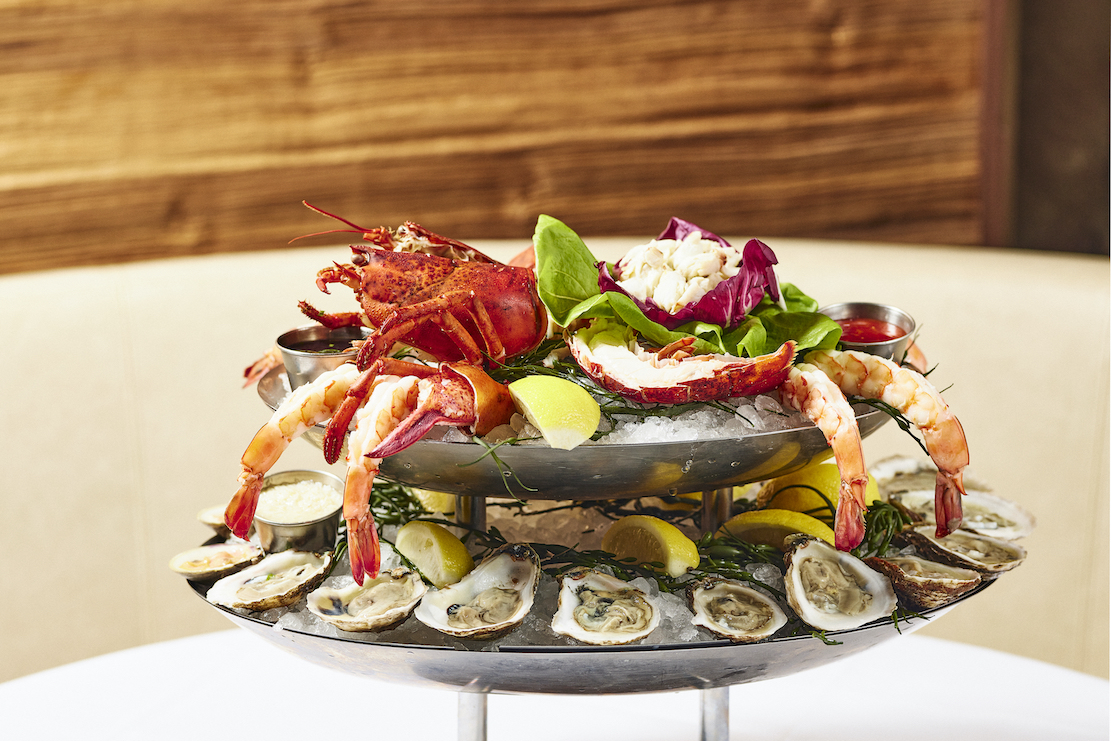 The
premises are by the Rockwell
Group—one of their best designs in years—and,
because of the cathedral-like size
of Avra, the noise level, depending on where you
sit, can be very high. If you can snare a
booth, you’ll be very comfortable.
The
premises are by the Rockwell
Group—one of their best designs in years—and,
because of the cathedral-like size
of Avra, the noise level, depending on where you
sit, can be very high. If you can snare a
booth, you’ll be very comfortable.
The menu is long and sectioned off,
and appetizers are enough for two people, like the
bountiful Greek salad
containing barrel-aged arahova sheep
and
goat’s milk feta ($28.95); the very tender and
well-seasoned octopus with
sweet Vidalia onions, capers, Bell peppers and
wine vinaigrette ($34.95); and
the tender fried calamari ($24.95).
I
love the way they fry zucchini, as
thin crepe-like discs stacked on one another to be
picked up hot and eaten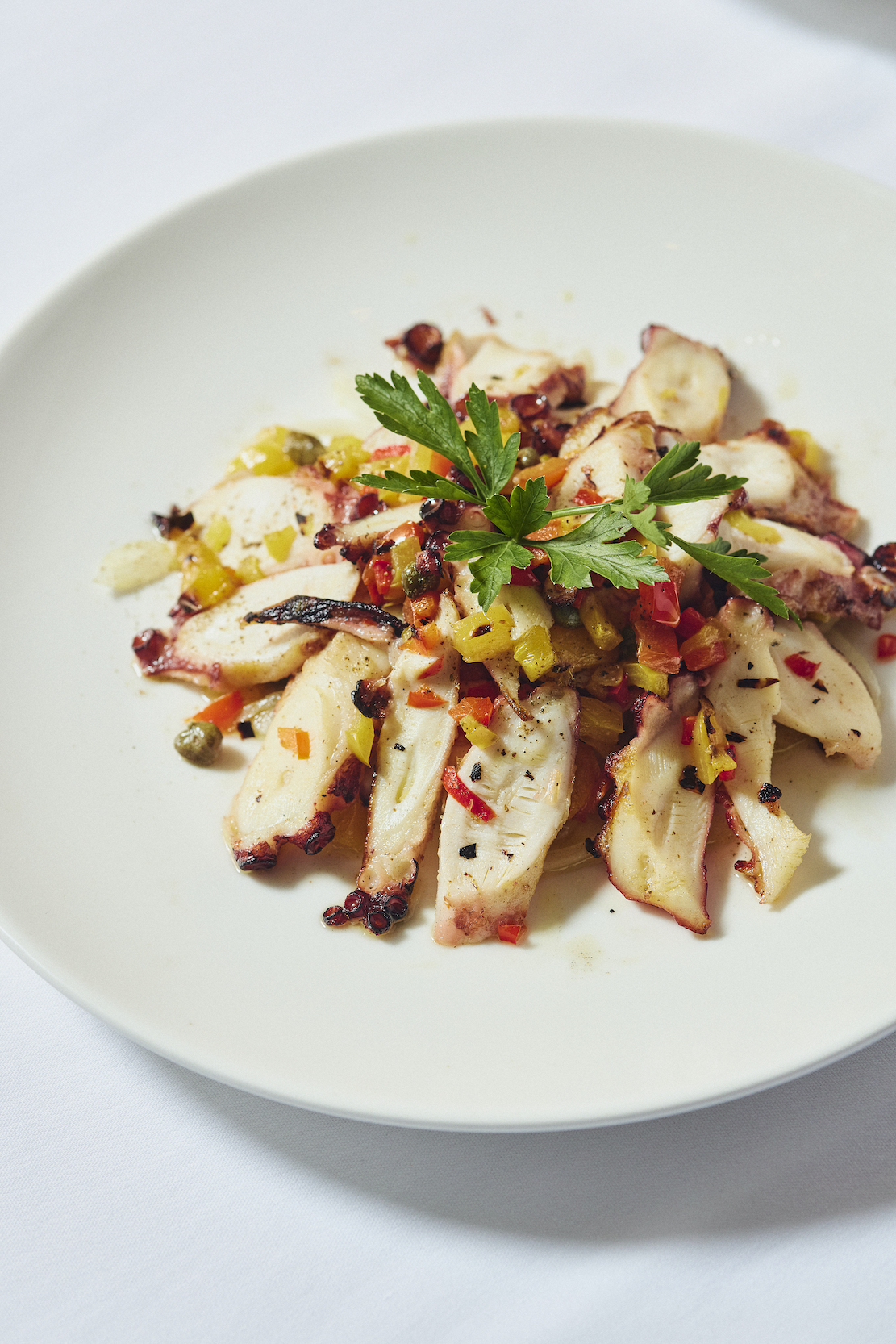 like
potato
chips ($26.95). There are a few ceviches, and our
lavraki (sea bass) had a generous
dressing of sesame
oil, Sriracha, endive, green and red
peppers, jalapeño and sesame seeds ($32.95). There
is one oddity worth
mentioning: You get crackers and dips to start,
but no pita bread; not even on
the menu.
like
potato
chips ($26.95). There are a few ceviches, and our
lavraki (sea bass) had a generous
dressing of sesame
oil, Sriracha, endive, green and red
peppers, jalapeño and sesame seeds ($32.95). There
is one oddity worth
mentioning: You get crackers and dips to start,
but no pita bread; not even on
the menu.
Avra RC is by any account
expensive, and with the fish priced
by the pound, as per the market, our whole grilled
fagri—a meaty, juicy sea bream—was
$61.95 per pound, making a
three-pounder ring in at a whopping $190.19,
shared by our table of four.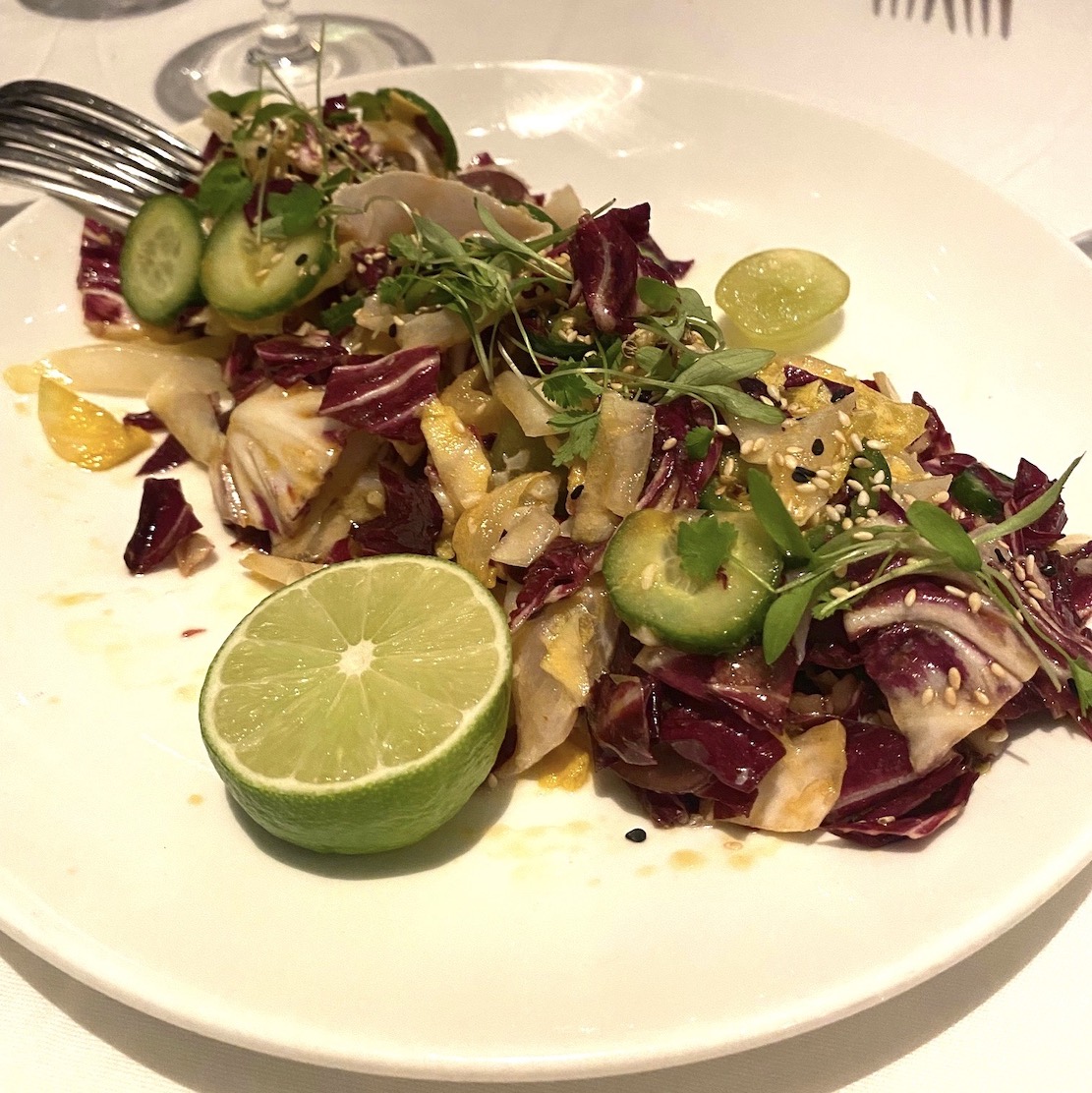 On
any given night there might be a dozen or more
species on the ice, ranging from
Mediterranean lithrini
(white
snapper) and tsipoura
(dorade) to
Scottish langoustines and Dover sole.
On
any given night there might be a dozen or more
species on the ice, ranging from
Mediterranean lithrini
(white
snapper) and tsipoura
(dorade) to
Scottish langoustines and Dover sole.
Among the meat dishes are American
wagyu and USDA Prime beef, and lamb chops
($64.95).
The side dishes at Greek restaurants
are always a treat. At Avra RC the gigante
beans are particularly savory ($15.50), as are
the grilled mushrooms
($15.50) and good sautéed spinach ($15.50).
A mountain of desserts came at the
end, the best being the honey-soaked baklavah.
Sad to say, a cup of not very hot Greek coffee was
watery and bland.
It goes without saying that Tsoulos
and his partners have realized dreams beyond their
imagining back in Greece,
and they set a tone and style that is as bright as
the décor is airy. If you’re
willing to spend the money, Avra RC will reward
you on many levels that are at
once romantic, festive and all in good taste. When
we left at 10:30 the place
was still more than half full, with people still
coming in. (Wednesday through
Saturday they close at midnight.).
While many restaurants take a
year or
more building a faithful clientele, Avra RC has
shot out of the gate to reach
that level—for all the right reasons.
Open
daily for lunch and dinner.
.
ANOTHER
VERMEER

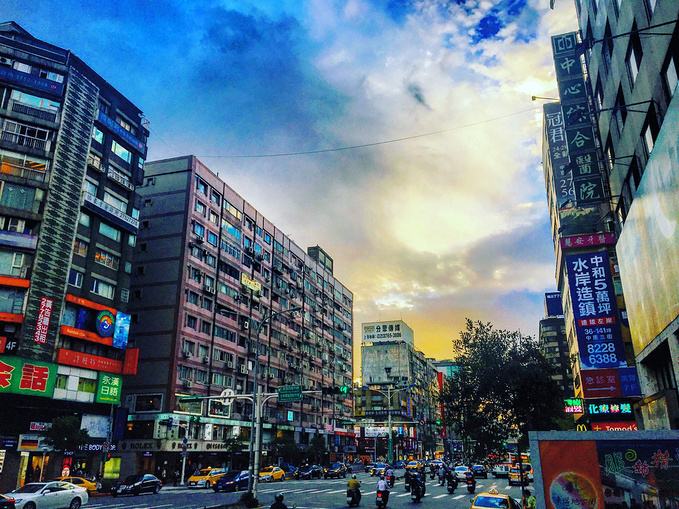 Shui
Enterprises was located on
Zhongxio Road in the downtown business
district, which was being widely
excavated for new skyscrapers. The building
was just five years old, box-like
and nondescript, its façade set with both
Chinese and English lettering.
Shui
Enterprises was located on
Zhongxio Road in the downtown business
district, which was being widely
excavated for new skyscrapers. The building
was just five years old, box-like
and nondescript, its façade set with both
Chinese and English lettering.
“You ready?” asked David, opening
the taxi door.
“Let’s do it,” said Katie. “I think
Mr. Shui is in for a surprise.” It was five
minutes to ten.
They entered the lobby and
approached the main desk, announcing their
names, saying they had an appointment
with Mr. Shui at ten o’clock. The receptionist
nodded and checked her list,
then looked up and said, “I’m sorry, Ms. Cavuto,
I do see that you had an
appointment,
but it’s been marked as
canceled.”
“I don’t think that’s correct,” said
Katie. “There must be some mistake. Can you call
Mr. Shui’s office and check,
please?”
“Of course. Please wait a moment.”
The receptionist picked up the phone
and spoke in a low tone to an associate.
As they spoke, the receptionist kept
looking at Katie and David, at
first smiling, then with her eyes widening. The
conversation went on for a
minute, then the receptionist said, “I’m sorry,
Ms. Cavuto, there seems to be
some misunderstanding. But Mr. Shui’s personal
assistant will be down in a
moment to assist you.”
“Sounds like the misunderstanding is
over whether or not we’re dead,” David whispered
to Katie.
“I feel fine. How about you?”
“I’m good.”
A long five minutes passed, then two
men approached Katie and David, bowing slightly,
trying to look restrained but in
a state of shock. One of them spoke, stuttering
over his words.
“Ms. Cavuto, Mr. Greco, I am Chun
Guanting, Mr. Shui’s personal assistant . . .
and this . . .
is Mr. Guo. We . . . we are very
surprised to
see you here this . . . this morning. We
heard you had been . . . in a terrible accident
at the Grand Hotel.”
Katie and David looked at each other
and shook their heads.
“No, we’re fine,” she said.
“Couldn’t be better.”
“Ah,” said David, “you may be
referring to the American couple who were found
dead in their room, the one
that Mr. Shui wished us to stay in last night.”
The man named Guanting looked
increasingly confused, saying, “Forgive me, but
. . . you say . . . another
couple was in the room and were
. . . killed
. . . er, found dead?”
“Yes, what did you hear?”
“We were informed two Americans had
died but, forgive me, we believed you had been
in that room last night.”
“Luckily, no. There was a gas leak
in the room. We were down the hall in another
room. Didn’t Mr. Chou, the
general manager, tell you we changed rooms?”
Guanting spoke to Guo in Chinese,
then said, “If I may just make an inquiry . . .
I will be back very
shortly. Please,
please, make yourselves
comfortable here. I shall have some tea brought
to you.”
David looked at Katie as if to say,
“I wouldn’t drink it if I were you.”
Guanting left the lobby, leaving Guo
behind, his hands folded at his waist.
David looked him over to see if he was
carrying a weapon.
Nothing he could see.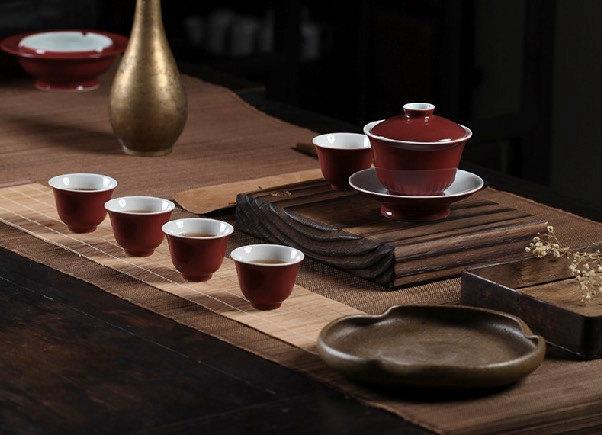 Five more minutes went by. The tea,
set on an elaborate tray, arrived, but before
the two Americans had a chance to
say no thanks, Guanting was back, asking if they
would come with him to meet
with Mr. Shui. “He is very concerned about your
welfare,” said Guanting.
Five more minutes went by. The tea,
set on an elaborate tray, arrived, but before
the two Americans had a chance to
say no thanks, Guanting was back, asking if they
would come with him to meet
with Mr. Shui. “He is very concerned about your
welfare,” said Guanting.
As the four of them went up in the
elevator, David asked, “So did Mr. Chou tell you
we changed rooms?”
“I do not know,” said Guanting.
“Did he call Mr. Shui early this
morning and tell him that two people had been
killed in the room?”
“I am sorry, I do not know. Perhaps
Mr. Shui will know.”
They were
ascending in a private
elevator, stopping at the 15th floor. Katie
noticed, contrary to elevators in
the west, that there was a
13th floor
button; apparently the Chinese regard it as a
lucky number.
They exited the elevator and were
ushered into an office where a secretary, saying
nothing, bowed, then led
Katie, David and the two other men into a large
wood-paneled office, set with
exquisite Chinese artwork. Mr. Hai Shui, all
five feet three inches of him, was
standing, squinting intensely at the two
Americans, as if making sure they were
not ghosts.
“I see you are . . . all right,”
said Shui.
“Yes,” answered Katie, who
introduced herself and David, without getting a
bow or handshake from their
host. “We are fine, Mr. Shui. We were in another
room when the accident
happened.”
“And may I ask why you were put in
another room after I asked Mr. Chou to put you
in that suite as my guest?”
Katie glanced at David. So clearly
Chou had never called Shui about the change the
day before, probably
embarrassed to do so.
“It was a generous offer, Mr. Shui,”
said Katie, “but my magazine does not permit me
to accept such lavish gifts,”
then, before he had a chance to respond, she
asked, “Well, did Mr. Chou speak
to you this morning about the accident?”
Despite Katie’s matter-of-fact tone,
Shui already sensed he was being interrogated.
“No, I have not heard from Mr.
Chao, but we have associates staying at the
hotel and they had heard about it
and called my office.”
“I can understand, then, why you
thought our appointment this morning would be
canceled,” said David, deadpan.
“Yes, yes, of course,” said Shui.
“We were shocked by the news, and we were
waiting to hear more.” He
said something to his assistants in
Chinese.
Katie and David were now seated and
she brought out her notepad and asked if she
might use her tape recorder.
“I am afraid not, Ms. Cavuto,” said
Shui. “We have a policy against that in this
office,” then nodded to Guo to
remove the recorder from the table. He put it
into his jacket pocket.
“Not a problem,” said Katie,
smiling. “Well, as you know, I am doing a story
on the sale of the Jan Vermeer
painting that is coming to auction this month,
and I understand you might be
bidding on it.”
“Perhaps so,” said Shui.
“And from what I’ve read, there may
be some special attachment you and your family
have to this painting?”
Shui had not expected Katie’s
question, intrigued that she’d made a connection
no one else had ever
suggested. “And why do you say that?”
Katie
quickly summarized, in as few words and as
clearly as possible, the theories
hatched months before in the Fordham University
office, how the words “sui jen”
and the clues that tied the
painting to China, or at least Asia, might refer
to Shui’s family or “gold
across the water,” perhaps both.
Mr. Shui held his fingers under his
chin and showed a slight smile.
“You have done your homework, Ms.
Cavuto. I
congratulate you on your
findings, so let me tell you the rest of the
story.”
Katie flipped to a
fresh page in her
notebook and poised her pen for her form of
shorthand.
“You are correct about the phrase ‘sui jen,’
in both senses.
It is—what do you call it?—a . . . pun?
My
ancestors did indeed request a Dutch artist to
make such a painting to
commemorate a business transaction with the
Dutch to buy gold from them, which
was very rare in China then.
“Apparently,
my ancestors could not
afford to have a master like Rembrandt paint a
picture for us, but I suppose
this young artist Vermeer was recommended, so he
got the contract. I can only
suppose my ancestors looked at two similar
paintings, which you may be familiar
with, The
Astronomer and The
Geographer? Perhaps Vermeer
suggested a version like those.”
Katie and David nodded.
“Ah, good. So, the painting was
commissioned—we still have the documents—and
some time later, perhaps by 1670,
the painting was transported to my ancestors’
home in Beijing. And there it
stayed for hundreds of years. No
one,
not even the western art critics, had much
knowledge of Vermeer’s work, or
cared very much about it.”
“So your family’s Vermeer just sort
of got lost in history?” asked David.
“Yes, until the revolution. I’m sure
you know that when Mao Zedong fomented his
disgraceful rebellion against the
Chinese people, the Nationalist Chinese tried to
move as many of China’s art
treasures as possible here to Taiwan. During
that time many, many works of art
long forgotten were being scrutinized, and my
parents had always hung the
painting out of the way, in their private
quarters.
“My family tried to take with them
as much artwork as possible but it was
impossible, and my father, who had only
a sentimental attachment to the Vermeer—this was
back in 1949—decided he could
not take it on the last shipment out of China.
Along with many lesser works,
the Vermeer stayed in China for the next four
decades, until it was announced
it would be auctioned off in Hong Kong.”
“Was it in the National Museum in
Beijing?” asked David.
“If it was, it was never displayed.
Perhaps they had no idea what they had, and
anyway western art was considered
decadent until recently.”
❖❖❖
J. LOHR PLANS FOR THE FUTURE
By John Mariani
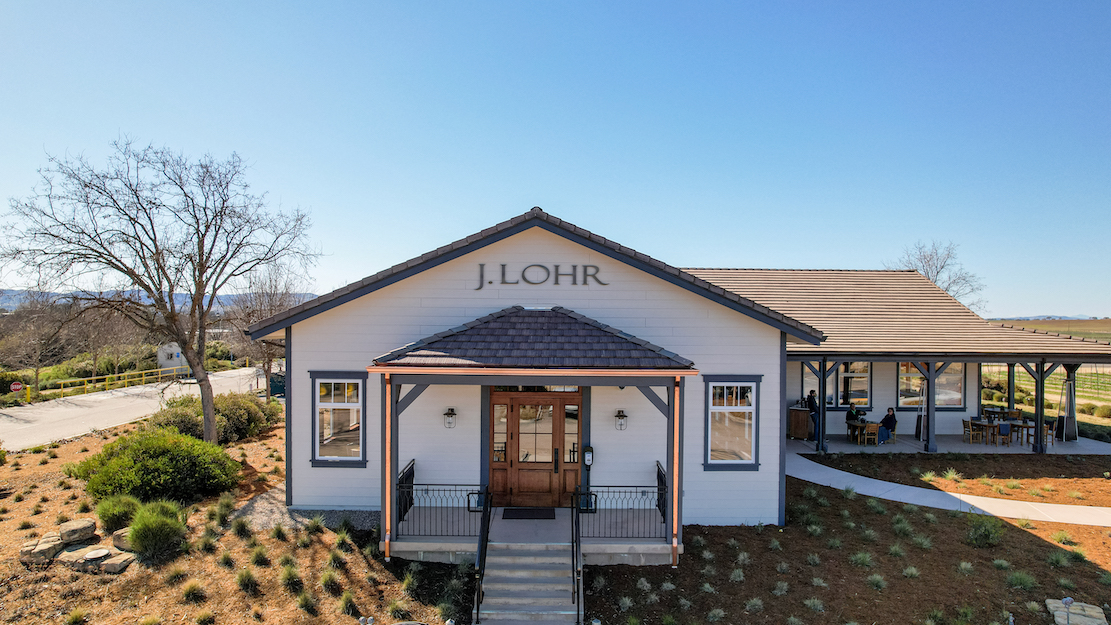
Back
in the 1960s, Jerry Lohr, who had been raised on a
South
Dakota farm, sought vineyard land in California’s
Central Coast area at a time
when Napa Valley was just starting to experiment
with what led to the
California Wine Revolution of the 1970s, when Lohr
was planting Cabernet
Sauvignon in Monterey’s Arroyo Secco district. A
decade later he was being
called the “Robert Mondavi of the Central Coast.”
Now eighty-five, Lohr is as
involved and forward-thinking as many of the
second-generation California winemakers,
who got into the business because Lohr proved it
could be very profitable.
In New
York I sat down over dinner with
J. Lohr Vineyards & Wines’ Rhonda Motil (below),
Vice President Marketing, to find
out what the future holds for the company and the
business of wine.
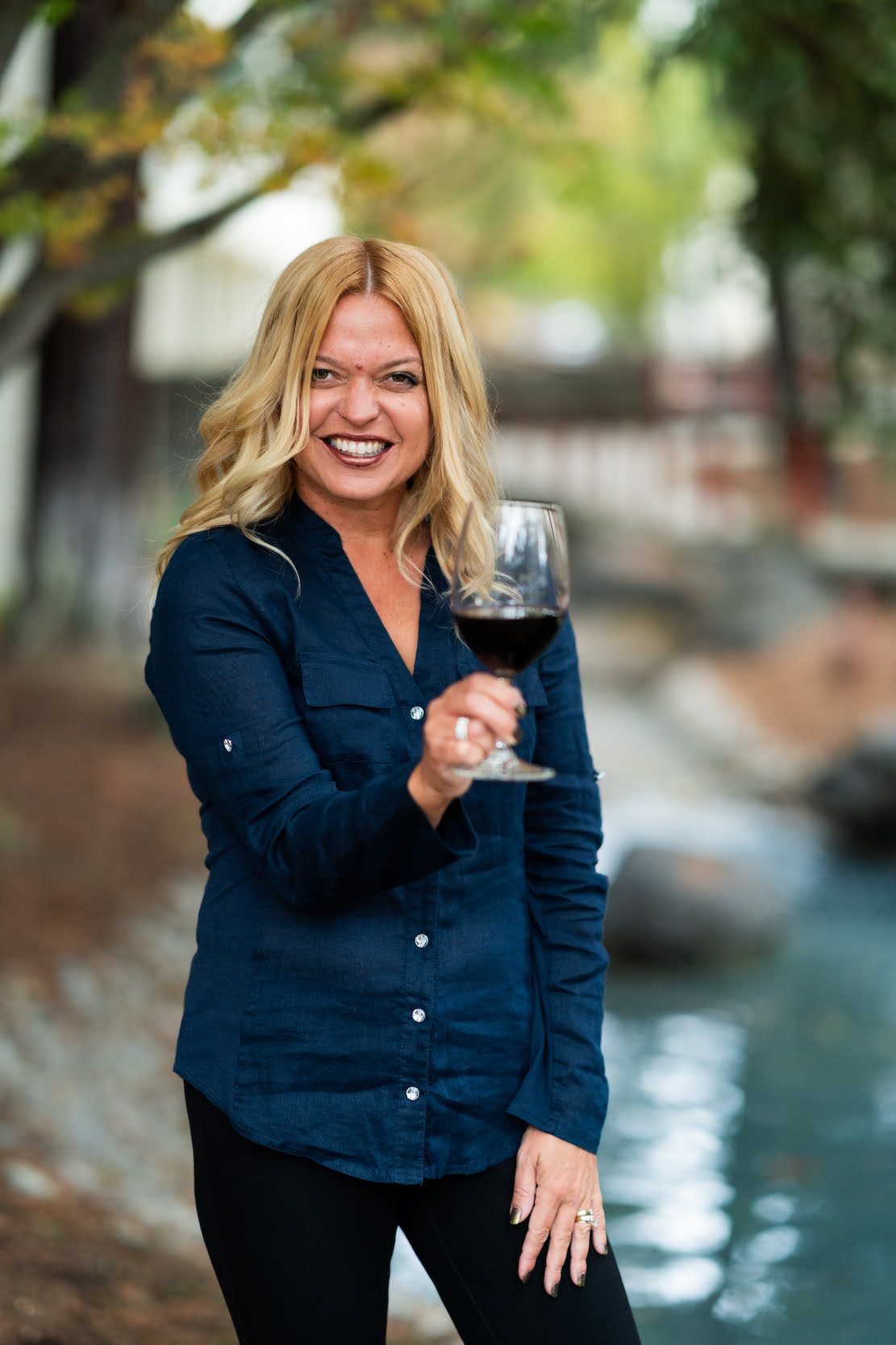 Over the years of your
tenure at J. Lohr, what have been the major
changes?
Over the years of your
tenure at J. Lohr, what have been the major
changes?
The role of marketing has
changed significantly since I first entered the
field 25 years ago. Three
highlights immediately jump out to me beyond
traditional media:
When I was transitioning
into J. Lohr even ten years ago, the role of social
media platforms,
influencers and ratings/reviews by third parties,
beyond key wine publications,
was not really even in consideration as a required
“skill set.” That has all changed now.
Therefore, truly understanding the brand
and where consumers reside as they make purchasing
decisions is key. The path
to purchase was a bit more straightforward twenty
years ago.
Second, digital and
e-commerce: From virtual tastings during the course
of the pandemic, for both
trade and consumers, to innovation in e-commerce, J.
Lohr has embraced digital
wholeheartedly.
Third, the team’s efforts
have contributed to gaining e-Commerce market share
in the online wine category
at an extremely fast rate. Our consistent brand
representation across all
online channels where a bottle of J. Lohr can be
bought has been a quick but
important ramp. Website traffic has more than
doubled from 2019 compared with
2021. (The 2020 Covid year was obviously an
outlier.)
We’ve done innovation in packaging and
over the past five years we have
launched three new tiers of wines. The most
recent tier launch, J. Lohr
Monterey Roots, was acknowledged as the 2022
People’s Choice industry leader
for Packaging Redesign and Packaging in a Series.
Now more than ever, consumers
are interested in innovation.
As VP of Marketing how do you work
with the family on decisions?
Jerry Lohr has always been
of the philosophy that it takes a team to have
success. Therefore, our culture
is built upon “extended family.” I view Jerry as
quite the mentor and I will
always be grateful for his guidance on my entry into
the wine industry. Jerry
was leading the executive search committee back in
2001 when the Monterey
County Vintners & Growers Association was
seeking an Executive Director to
lead the growing trade association. While I had
little industry experience at
the time, Jerry felt that he saw talent and that the
skills and knowledge of
the wine industry that I lacked could be taught. I
was fortunate to be hired
into that job and retained the role for ten years
before transitioning to J.
Lohr. 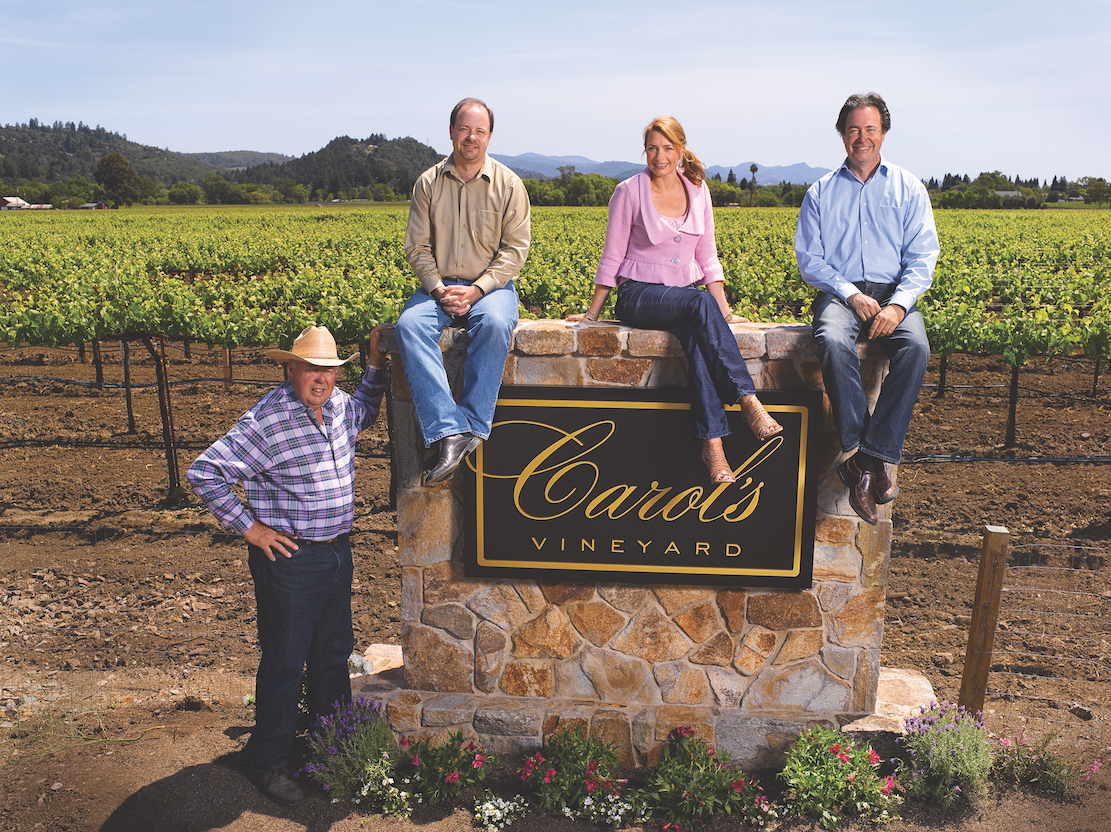
I assumed the role of VP
Marketing in 2016, succeeding Cynthia Lohr, who
winnowed her focus to trade and
brand strategy. Now, twenty years later, and nearly
another ten years with J.
Lohr, I am part of an extended group of leadership
that the family collaborates
with on decisions and marketing direction, including
collaborating hands-on
with Cynthia, now Chief Brand Officer (right,
middle), who oversees marketing, branding and
direct-to-consumer sales. This includes not only
weekly input sessions, but
ongoing touch-base sessions on consumer direction
and preferences. The market
is moving so fast that this regular dialogue and
partnership is key.
Do you use panels to test out your
ideas?
Customer perspectives and
target market feedback are extremely important for
us as we make business and
marketing decisions. We are fortunate that we have a
large Wine Club base that
is actively involved at J. Lohr. These diverse brand
ambassadors span every
demographic and area of the U.S., which gives us a
great pool of ambassadors to
get feedback from.
Tell me about the virtual tastings
during Covid.
We were an early adopter of
virtual tastings during Covid because we knew it was
key to consumer
engagement. We tested a number of different formats
but landed on “At Home with
J. Lohr,” a program which launched in May of 2020
with a schedule of virtual
events under my team’s direction, with the idea of
providing a fun and engaging
digital space where we could creatively connect with
our friends, family and
extended J. Lohr family. As you explore the “At Home
with J. Lohr” page, you'll
find our J. Lohr Family, Place,
and Craft
virtual events. These were debuted first to
our J. Lohr Wine Clubs on May
6, 2020, where we brought to life the unique stories
of our winemaking team,
our chosen appellations, and our commitment to
sustainable practices as well as
winemaking leadership that are at the heart of our
business.
Post-Covid, how has wine tourism
rebounded?
During the height of Covid,
we took the opportunity to review and reimagine all
hospitality spaces at both
our J. Lohr Paso Robles Wine Center and our J. Lohr
San Jose Wine Center, all
led by Cynthia Lohr in continued efforts to
restrategize our direct-to-consumer
business. Understanding trends in both indoor and
outdoor experiences, seated
tastings, and reservation-style communications
shaped many of our decisions.
During a time of uncertainty, it was also important
that we maintained a growth
mindset within the team, brainstorming use of space,
how to provide consistent
high-touch service, how to add personalization to
experiences, and how to best
connect with our J. Lohr fans in our “new normal.”
We initially prioritized
expansion of our outdoor seated tastings, modifying
these experiences
seasonally to feature J. Lohr small-lot,
single-vineyard, and winery-exclusive
gems. In San José`, we took advantage of our urban
neighborhood setting and
staged our outdoor setup against the backdrop of our
beautiful brick façade.
In Paso Robles, we positioned our guests with
endless views of vineyards and
oaks. Regardless of location, increased attention to
detail with outdoor
experiences allowed us to maintain these offerings
throughout the seasons.
Our Paso Robles tasting room reopened in
February 2022 with every element of the room being
touched and improved upon.
Recognizing throughout the brainstorming process
that we have even more
potential for expanded offerings, we continued with
the planning and broke
ground in October 2022 for the next phase of our
Paso Robles remodel, to
include a Tasting Salon with all seated tastings,
lounge seating, a fireplace,
and a private room for our most elevated
experiences. Utilizing inspiration from
indoor-outdoor entertaining that became even more
popular during Covid, this
room will fully open to an extended patio that leads
guests to our
demonstration vineyard.
As we
commence the
next remodel phase in Paso Robles, we are also
wrapping up improvements to our
J. Lohr San Jose Wine Center. New to the space in
2022 is stylish and
comfortable furniture so that we can continue to
elevate the guest experience
both indoors and outdoors. A critical piece that is
top-of-mind post-Covid is
recruiting and retaining the right talent. Jessica
Kolloff, senior industry
hospitality expert for 20 years, works closely with
Cynthia to build and
inspire a team of J. Lohr hospitalitarians. The
development and transformation
of the entire hospitality team, while watching them
interact with guests who
are eager to experience life again, may be the most
rewarding aspect in a
post-Covid world.
Our wine colleagues and
friends to the north of J. Lohr’s primary vineyards
in Monterey and Paso Robles
have been hit harder by fires that have occurred in
California in recent years.
That noted, we do have a beloved 35-acre vineyard in
Napa and we consistently
monitor climatic factors that are impacting the
area.
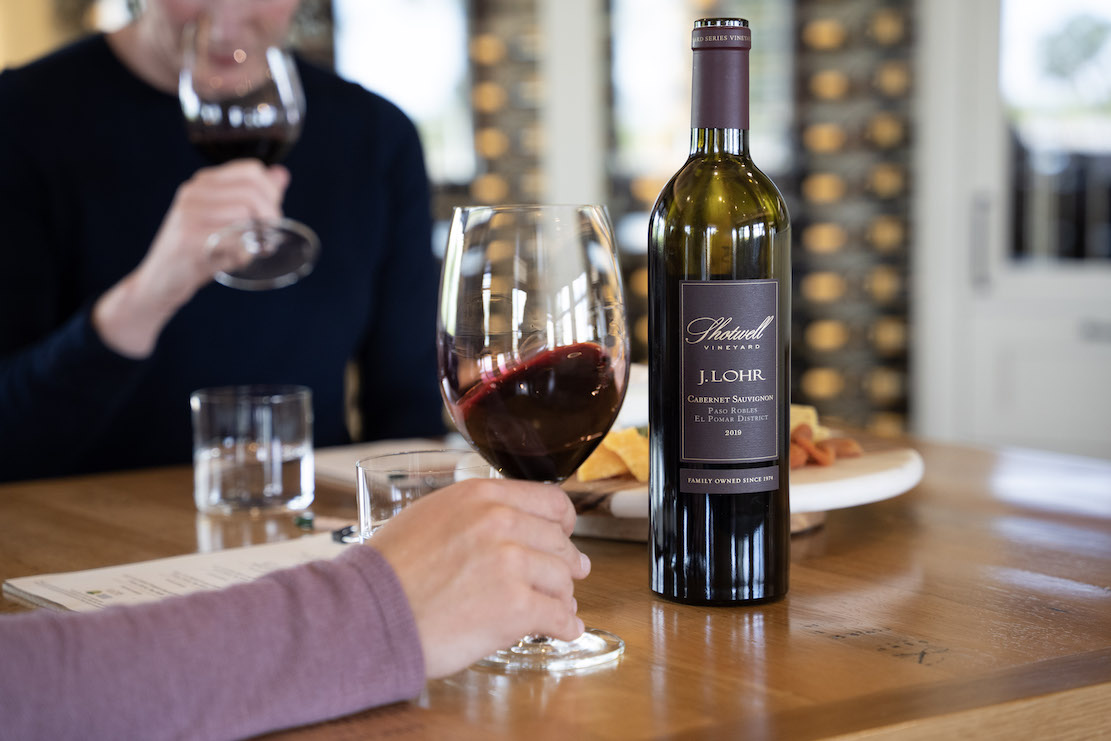
How about drought?
Central Coast wineries are
certainly vulnerable to drought, and we’ve .
spearheaded several initiatives
and research to combat these challenges, which is a
complex and evolving area.
What can be done to reduce the
footprint of glass bottles in the
future? Thinner, stronger bottles?
Glass suppliers are working
on durable, light-weight molds that are compatible
with existing bottling lines
that could potentially reduce the overall bottle
weight by as much as 15%.
However, producing light-weight glass is not an easy
task, as a bottle is only
as strong as its weakest spot. We continue to
diligently monitor best practices
and lightweight glass manufacturing, as producing
sustainable products and
using vendors/supplies that are sustainable, are
always top of mind for us. J. Lohr also believes
there
is an opportunity with keg wine to help reduce the
carbon footprint of glass
bottles. We were one of the early wineries to
embrace a wine-in-keg program. We
did this partly for sustainability reasons, and
partly to reach a newer,
younger demographic. Two of our key J. Lohr Estates
wines, our J. Lohr Estates
Flume Crossing Sauvignon Blanc and our J. Lohr
Estates Falcon’s Perch Pinot
Noir, are offered in kegs.
Has the wine industry put serious
effort into using solar power?
We have a solar tracking
array system that provides our Paso Robles facility
with 75% of its electrical
needs and another in Greenfield that provides the
Greenfield winery with 100%
of its needs. It’s worth noting that our Paso Robles
tracking array (which is
still the largest in the North American wine
industry) follows the path of the
sun, making it more efficient than fixed arrays.
Why did you promote your 375 ml
bottles?

There are so many options now for consumers, and we know that the younger consumer is a bit more willing to explore. In the just-released Nielsen 2022 Mid-Year Review, the stats showed that the convenience channel whiskey is up 4.6%YTD. Though buying trends indicate that millennials aren’t buying as much wine as Baby Boomers, we’re addressing this by continuing to create new and enticing marketing strategies to keep the younger consumer interested in our wines. We recently unveiled J. Lohr Monterey Roots, a new tier of wines that spotlight our history of family viticulture and winemaking in Arroyo Seco in Monterey County. Both wines bear the Certified California Sustainable seal on their back labels. With this tier, we’re attracting the next generation of wine consumers by focusing on the fun, adventurous, no-attitude spirit of these wines. The fact that these wines are Certified California Sustainable, and under 90 calories a glass. appeal both to the values and the lifestyle choices that many new consumers are seeking and embracing.
Family ownership in day-to-day management definitely differentiates J. Lohr from its competitors. Steve, Cynthia, and Lawrence Lohr grew up in the business and have worked closely with their father in every aspect of the company. Steve is President and CEO and continues Jerry’s tradition of industry service. Steve is a past Chair of both the Wine Institute and California Sustainable Winegrowing Alliance. Cynthia is the company’s wide-ranging Chief Brand Officer. Her leadership positions such as past Vice President of the Paso Robles CAB Collective and member of the Advisory Council for Women of the Vine & Spirits, among other posts, are a natural evolution as Chief Operating Officer, Vineyards and she works alongside Jerry on projects involving the company's estate wine growing properties and supports the winery’s national sales and marketing programs. Lawrence also serves on the board of directors for Wine Institute and the Monterey County Vintners & Growers Association. Acting together as the executive team, all four Lohr family members oversee the company’s day-to-day operations. The experience and passion of this next generation of the Lohr family ensure that one of California’s historic, best-known wineries is in good hands – today and into the future.
We take great pride in the practice of “Produced and Bottled.” Owning our own vineyards and wineries enables us to produce consistently superior wines, vintage after vintage. Complete “soil to bottle” management is the key to that quality and craft. This rigorous, integrated philosophy is echoed in the legal term “Produced and Bottled By” on J. Lohr back labels. It is a guarantee of category leadership and a commitment to consistently over-deliver on quality at every price point. We feel that this is not only a differentiator now, but for years to come.
We will continue designing innovative in-store and restaurant campaigns that appeal to major accounts. Efforts have contributed to positioning the J. Lohr’s Estates-tier of Cabernet as the #1 selling AVA-designated wines in its respective category, per Nielsen. We will continue to hone in on our philanthropic partner programs; inclusive of our J. Lohr Touching Lives partnership with National Breast Cancer Foundation, and manage marketing team oversight of 200+ annual relationships and donations. Consumers want to be affiliated with, and buy products from, brands that they know are making a difference in their communities and the world.
We believe that sharing details on our sustainability efforts and programs is important. Research has shown that products that are sustainable carry added meaning for consumers in their purchasing decisions. In recognition of our commitment, we received the 2020 Green Medal Leader Award, which is the highest California sustainability honor in the industry. We now have over 25 wines that have been certified as sustainable.
❖❖❖
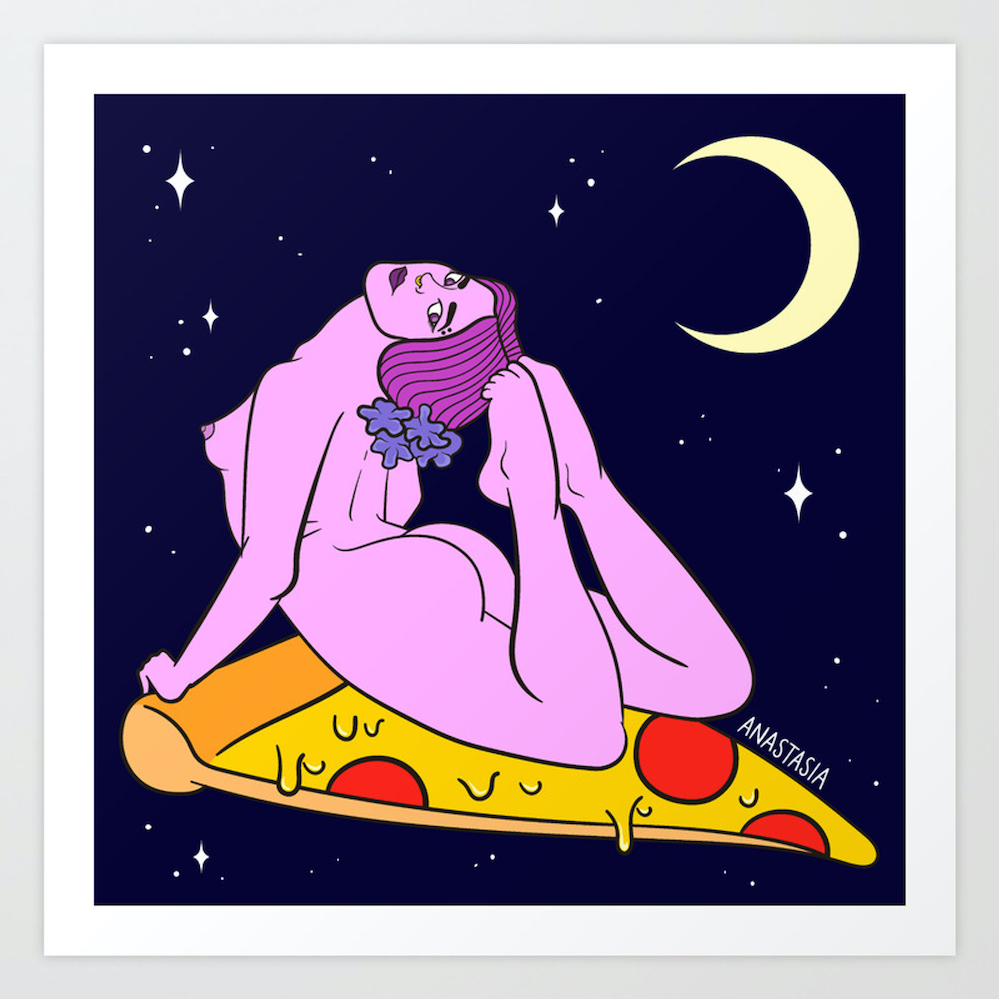
ANNALS OF GREAT JOURNALISM
“A Life-Changing Clam Pizza”—by Nikita Richardson NYTimes
(9/14/22)
❖❖❖
Any of John Mariani's books below may be ordered from amazon.com.
 The Hound in Heaven
(21st Century Lion Books) is a novella, and
for anyone who loves dogs, Christmas, romance,
inspiration, even the supernatural, I hope you'll find
this to be a treasured favorite. The story
concerns how, after a New England teacher, his wife and
their two daughters adopt a stray puppy found in their
barn in northern Maine, their lives seem full of promise.
But when tragedy strikes, their wonderful dog Lazarus and
the spirit of Christmas are the only things that may bring
his master back from the edge of despair.
The Hound in Heaven
(21st Century Lion Books) is a novella, and
for anyone who loves dogs, Christmas, romance,
inspiration, even the supernatural, I hope you'll find
this to be a treasured favorite. The story
concerns how, after a New England teacher, his wife and
their two daughters adopt a stray puppy found in their
barn in northern Maine, their lives seem full of promise.
But when tragedy strikes, their wonderful dog Lazarus and
the spirit of Christmas are the only things that may bring
his master back from the edge of despair. WATCH THE VIDEO!
“What a huge surprise turn this story took! I was completely stunned! I truly enjoyed this book and its message.” – Actress Ali MacGraw
“He had me at Page One. The amount of heart, human insight, soul searching, and deft literary strength that John Mariani pours into this airtight novella is vertigo-inducing. Perhaps ‘wow’ would be the best comment.” – James Dalessandro, author of Bohemian Heart and 1906.
“John Mariani’s Hound in Heaven starts with a well-painted portrayal of an American family, along with the requisite dog. A surprise event flips the action of the novel and captures us for a voyage leading to a hopeful and heart-warming message. A page turning, one sitting read, it’s the perfect antidote for the winter and promotion of holiday celebration.” – Ann Pearlman, author of The Christmas Cookie Club and A Gift for my Sister.
“John Mariani’s concise, achingly beautiful novella pulls a literary rabbit out of a hat – a mash-up of the cosmic and the intimate, the tragic and the heart-warming – a Christmas tale for all ages, and all faiths. Read it to your children, read it to yourself… but read it. Early and often. Highly recommended.” – Jay Bonansinga, New York Times bestselling author of Pinkerton’s War, The Sinking of The Eastland, and The Walking Dead: The Road To Woodbury.
“Amazing things happen when you open your heart to an animal. The Hound in Heaven delivers a powerful story of healing that is forged in the spiritual relationship between a man and his best friend. The book brings a message of hope that can enrich our images of family, love, and loss.” – Dr. Barbara Royal, author of The Royal Treatment.
 |
The Encyclopedia of American Food and Drink by John F. Mariani (Bloomsbury USA, $35) Modesty forbids me to praise my own new book, but let me proudly say that it is an extensive revision of the 4th edition that appeared more than a decade ago, before locavores, molecular cuisine, modernist cuisine, the Food Network and so much more, now included. Word origins have been completely updated, as have per capita consumption and production stats. Most important, for the first time since publication in the 1980s, the book includes more than 100 biographies of Americans who have changed the way we cook, eat and drink -- from Fannie Farmer and Julia Child to Robert Mondavi and Thomas Keller. "This book is amazing! It has entries for everything from `abalone' to `zwieback,' plus more than 500 recipes for classic American dishes and drinks."--Devra First, The Boston Globe. "Much needed in any kitchen library."--Bon Appetit. |
"Eating Italian will never be the same after reading John Mariani's entertaining and savory gastronomical history of the cuisine of Italy and how it won over appetites worldwide. . . . This book is such a tasteful narrative that it will literally make you hungry for Italian food and arouse your appetite for gastronomical history."--Don Oldenburg, USA Today. "Italian
restaurants--some good, some glitzy--far
outnumber their French rivals. Many of
these establishments are zestfully described
in How Italian Food Conquered the World, an
entertaining and fact-filled chronicle by
food-and-wine correspondent John F.
Mariani."--Aram Bakshian Jr., Wall Street
Journal.
"Equal parts
history, sociology, gastronomy, and just
plain fun, How Italian Food Conquered the
World tells the captivating and delicious
story of the (let's face it) everybody's
favorite cuisine with clarity, verve and
more than one surprise."--Colman Andrews,
editorial director of The Daily
Meal.com. "A fantastic and fascinating
read, covering everything from the influence
of Venice's spice trade to the impact of
Italian immigrants in America and the
evolution of alta cucina. This book will
serve as a terrific resource to anyone
interested in the real story of Italian
food."--Mary Ann Esposito, host of PBS-TV's
Ciao
Italia. "John Mariani has written the
definitive history of how Italians won their
way into our hearts, minds, and
stomachs. It's a story of pleasure over
pomp and taste over technique."--Danny Meyer,
owner of NYC restaurants Union Square
Cafe, The Modern, and Maialino.
|
 |
 |
 |
 |
 |
 |
 Everett Potter's Travel Report:
Everett Potter's Travel Report: 
 Eating Las
Vegas
Eating Las
Vegas
MARIANI'S VIRTUAL GOURMET
NEWSLETTER is published weekly. Publisher: John Mariani. Editor: Walter Bagley. Contributing Writers: Christopher
Mariani, Misha Mariani, John A. Curtas, Gerry Dawes, Geoff Kalish.
Contributing
Photographer: Galina Dargery. Technical
Advisor: Gerry
McLoughlin.
If you wish to subscribe to this
newsletter, please click here: http://www.johnmariani.com/subscribe/index.html
© copyright John Mariani 2022
